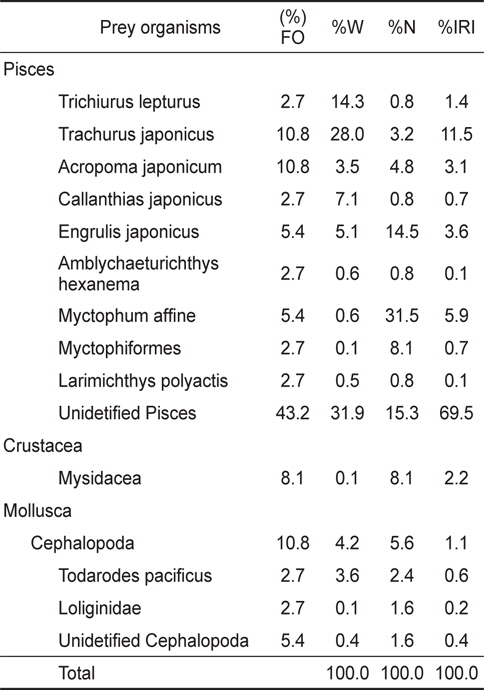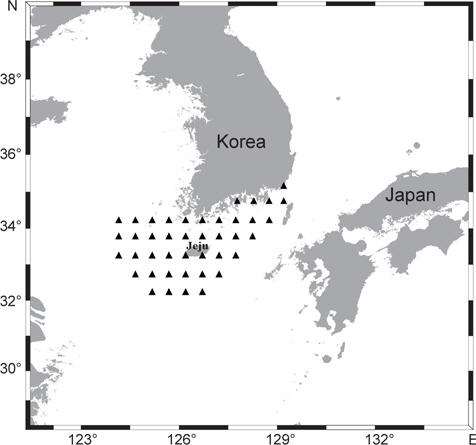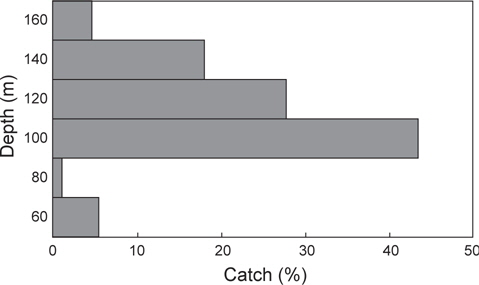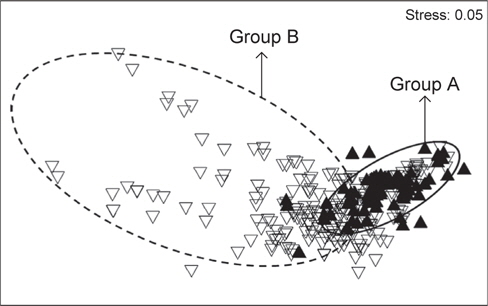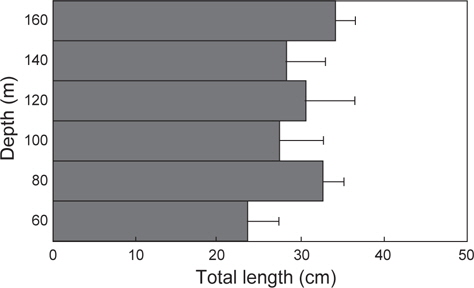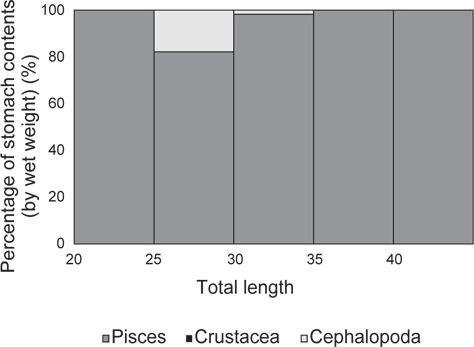민달고기(Zenopsis nebulosa)는 달고기목(Order Zeiformes) 달고기과(Family Zeidae)에 속하는 어류로서 우리나라 남부해를 포함하여 일본 중부이남, 동중국해, 대만 그리고 중 서부 태평양까지 분포하며(Kim et al., 2005) 수심 30-800 m 이내에 서식한다(Froese & Pauly, 2002, Knuckey and Curtain, 2001). 민달고기는 골격이 단단하며 옆으로 납작한 몸의 형태를 가졌고, 아래턱은 길게 늘어나 입은 큰편이다(Koslow et al., 2000). 암컷의 경우 군성숙 전장이 대략 35 cm에 이르며 겨울 내내 산란을 한다고 알려져 있다(Koslow et al., 2000). 우리나라 주변 해역에 넓게 분포하고 있는 민달고기는 Koslow et al. (2000)의 연구에 의하면 소형어류들을 주로 섭이하는데 우리나라 주변 해역의 생태계 내에서도 마찬가지로 중요한 포식자의 위치에 있으며 해양생태계 내에 많은 영향을 미치고 있다. 그러나 국외에서는 민달고기의 포식자로서의 위치에 관한 연구(Zidowitz et al., 2002), 민달고기의 연령사정에 관한 연구(Knuckey and Curtain, 2001) 등 극히 적은 수의 연구논문만이 있었고 국내에서는 Gang (2005)에 의한 민달고기의 형태와 골격에 관한 연구가 있을 뿐 생태에 관한 자료는 전무한 실정이다. 최근 해수의 온도 상승으로 난류성 어종들의 출현이 증가하고 있는데 민달 고기 역시 난류성 어종으로서 우리나라 주변해역에서 넓은 분포 범위를 보이며 최근에는 매년 조사 때마다 출현을 하고 있다(Seo and Yoon, 2008, Kim et al., 2005). 점점 난류성 어종의 출현이 많아지고 있는 우리나라 해역에서 민달고기는 어떻게 분포하고 있는지에 대하여 알고자 하였으며 어떤 종들과 먹이경쟁 관계에 놓여 있는지 파악하기 위한 먹이분석을 실시하였다.
조사는 2009년부터 2013년까지 연 2회씩 총 5년에 걸쳐 국립수산과학원 탐구 20호 오터트롤(망고 3 m, 망폭 23 m, 망목 20 mm)을 이용하여 우리나라 남해안의 총 42개 정점에서 3-4 knot로 각 60분간 예망하였다 정점은 32°25′에서 35°25′ N과 124°25′에서 129°25′ E였으며 수심 18 m에서 152 m 사이의 범위에서 이루어졌다 (Fig. 1). 조사가 진행되는 동안 CTD (Sea-Bird SBE 9)로 수온, 염분을 측정하였으며 채집된 어류 샘플은 전장(0.1 cm, Total length)과 체중(0.1 g, Body weight)을 측정하였다. 측정한 샘플은 위내용물 분석을 위하여 위를 절취하여 10% 포르말린에 고정한 뒤 실험실로 운반하였고 운반된 샘플은 현미경(JP/SZX 51 and JP/SZX 7; Olympus, Tokyo, Japan)하에서 Kim et al. (2005), Hong et al. (2006), Min et al. (2004), Chihara and Murano (1997)를 참고하여 가능한 종까지 동정하였다.
수심과 전장(Total length) 사이에 유의한 차이의 유무를 판단하기 위해서 변이의 동질성(Homogeneity of Variance) 판단 후 Kruskal – Wallis test를 시행하였고 MINITAB, Version 12를 사용하였다. 각 정점간 민달고기의 출현유무를 알아보기 위하여 수심, 수온과 염분 data에 민달고기의 출현유무를 factor로 하여 다차원척도법 (non-Metric Multidimensional Scaling, nMDS)분석을 시행하였으며 PRIMER Version 5를 사용하였다. 먹이생물은 종류별로 개체수를 계수하고, 각 먹이생물의 크기는 전장 0.1 cm 단위까지, 습중량 0.01 g 단위까지 측정하였다. 위 내용물의 출현양상은 각 먹이생물에 대한 출현빈도(Fi: Frequency of occurrence), 먹이생물의 개체수비(Ni: Number of individual), 습중량비(Wi: Weight) 및 먹이생물의 상대중요도지수(IRI: Index of relative importance)로 나타내었다. 상대중요도지수(IRI)는 개체수비와 습중량비의 합에 출현빈도를 곱한 값인데(Pinkas et al. 1971) 이것을 백분율로 환산하여 상대중요도지수비(% IRI)를 구하였다. 이 외에도 샘플의 전장이 증가함에 따른 먹이생물의 변화를 알아보았다.
본 연구해역에서 채집된 개체는 총 621개체였으며 전장11-48 cm의 범위를 보였다. 샘플의 출현빈도는 수심에 따른 유의한 차이를 보였는데 채집된 전체 개체수의 약 89%가 80-140 m 사이의 수심에서 채집된 것을 확인 할 수 있었다(Fig. 2). 다차원척도법에 의하여 5년 동안의 각 조사 정점은 민달고기가 출현하는 그룹 A와 출현하지 않는 그룹 B로 나뉘는 것을 확인할 수 있었는데 이는 수심과 수온의 차이임을 알 수 있었다(nMDS analysis; Stress = 0.05, ANOSIM; Global R=0.082, P<0.01) (Fig. 3). 14°C 이하의 수온에서는 매우 적은 개체가 출현하다가 14°C 이상의 수온에서부터는 많은 개체가 출현하였으며 20°C이상의 수온에서도 매우 많은 개체가 출현하여 민달고기는 따뜻한 수온을 선호하는 것을 알 수 있었다. 수심에 따른 전장의 변화도 확인 할 수 있었는데 수심이 깊어짐에 따라 전장이 증가하는 양상을 보였다(K–W test, P<0.05) (Fig. 4). 실제로 Knuckey and Curtain (2001)의 연구에서도 연안의 개체보다 먼바다에서 서식하는 개체의 전장이 더 큰 것을 확인 할 수 있었는데 본 연구의 결과도 이와 일치하였다.
먹이생물 분석을 위해 사용된 개체는 총 128개체였으며 20-43 cm의 크기를 보였다. 식성분석에 사용된 개체의 전체 공위율은 71%로서 상당히 높은 공복률을 보였다. 먹이생물 분석을 통하여 어류가 민달고기의 주 먹이생물임을 알 수 있었는데 실제로 어류를 주 먹이로 하는 종들은 어류가 먹이로서의 효율이 높은 관계로 공복률이 상대적으로 높은 것을 확인할 수 있다(Choi et al., 2011, Baeck and Huh, 2004, Huh et al., 2006). 민달고기의 주 먹이생물은 어류로서 전갱이(Trachurus japonicas)가 11.5% IRI값을 보여 어류 중에서도 가장 높은 비율을 차지하였다(Table 1). 전갱이는 우리나라 주변해역에 많이 분포하며 수심 10-100 m내외의 중층 및 저층에서 서식하는 종이다(Kim et al., 2005, Cha et al., 2009). 본 연구에서 전갱이를 섭이한 개체는 제주도 남부의 수심 100 m지점에서 발견된 개체들 이었으며 이는 전갱이의 서식지와 거의 일치하는 지점이었다. 그 다음은 샛비늘치(Myctophum affine)로 IRI값이 6.1%를 나타냈다. 어류 다음 많은 비율을 차지한 분류군으로는 갑각류인 곤쟁이류였는데 이는 상대중요지수비 2.3%를 차지하여 어류 보다는 상대적으로 적은 비율이지만 어류 다음으로 높은 비율을 차지하였다. 그 외 섭이된 먹이생물군은 두족류였는데 살오징어(Todarodes pacificus)가 0.6%, 꼴뚜기류가 0.2 %로서 두족류는 총 1.1%를 차지하여 어류에 비하면 극히 적은 비율을 차지하였다. Rowling et al. (2010)의 연구에 따르면 민달고기는 소형어, 작은크기의 갑각류와 두족류를 주로 섭이한다고 하였는데 본 연구에서 섭이된 먹이생물 중에서 주 먹이 생물이었던 어류는 전장이15 cm를 넘지 않는 비교적 작은 개체들이었으며 두족류 역시 몸통길이가 6 cm미만의 비교적 작은 개체들로서 Rowling et al. (2010)의 연구결과와 거의 일치하는 결과였다. 또한 민달고기는 유영능력이 상당히 떨어지는 종이라고 알려져 있는데(Wheeler, 1969) 섭이된 먹이생물이 모두 소형 개체였던 점은 민달고기의 유영능력과 연관이 있을 것으로 추측할 수 있다. 전장에 따른 먹이생물의 변화를 살펴보면 25 cm 이상의 크기군에서부터 두족류의 섭이가 나타나기 시작하였는데 25 cm이상의 개체군에서는 약 17.9%를 차지하였고 30 cm 이상의 크기군에서는 1.6%가 섭이되었다. 갑각류인 곤쟁이류는 가장 작은 크기군에서부터 섭이되기 시작하였지만 극히 미량이었다 (Figure 5). Zidowitz et al. (2002)의 연구에서와 마찬가지로 모든 크기군에서 가장 많이 섭이된 먹이생물은 어류였으며 25-30 cm의 개체군에서 어류가 82%를 차지한 것 이외에는 나머지 크기군에서는 모두 어류가 99%이상을 차지하여 민달고기는 어식성 어류임을 확인 할 수 있었다. Zidowitz et al. (2002)는 Zenopsis속 어류들은 개체의 크기가 커질수록 먹이생물이 단편화 된다고 하였는데 본 연구에서도 마찬가지로 개체의 크기가 커질수록 먹이생물로서의 어류가 더욱 우점하는 결과를 보였으며 가장 큰 크기의 그룹에서는 어류의 비율이 100%를 나타냈다.




